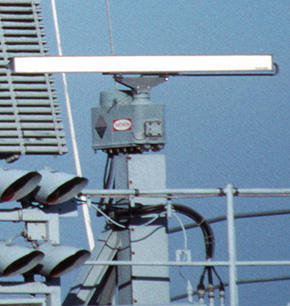Technical Studies to Support Examination of Sharing Options in the 2900-3100 MHz Band
The Federal Government uses the 2900 - 3100 MHz band of spectrum for operating various types of radar systems that are used for safe and reliable maritime navigation and accurate weather monitoring. This band is one of the bands NTIA is considering in its effort to fulfill the President’s goal of identifying 500 megahertz of spectrum for commercial wireless broadband by 2020. Three reports released today describe a multi-year research effort performed by NTIA’s Institute for Telecommunication Sciences (ITS) and funded by the United States Coast Guard providing technical information that can be used to examine different sharing options between marine radar systems operating in the 2900 - 3100 MHz band and commercial wireless broadband systems.

Marine radar slotted array antenna (white bar) mounted on motor which spins it.
Marine radar systems are authorized to operate in the 2900 - 3100 MHz band. These radars are used by ships to avoid collisions with objects while traveling in oceans, seas, lakes, and rivers. Detection of objects, referred to as targets, is often difficult. Rough seas, cross-section variation, and signal reflections or clutter from waves and precipitation can reduce the radar’s ability to detect a target. Interference can further reduce the operational range of the radar or cause the radar to not detect the target.

Bob Achatz is the lead author on all three reports.
The results of the NTIA research efforts have been documented in three technical reports. The first report NTIA Technical Report TR-15-513: Effect of Broadband Radio Service Reallocation on 2900–3100 MHz band Marine Radars: Background provides background information needed to understand the potential effects of sharing on S-band marine radars, including a discussion of the scenario, interference protection criteria, and propagation models used to perform the analysis. The second report NTIA Technical Report TR-15-514: Effect of Broadband Radio Service Reallocation on 2900–3100 MHz band Marine Radars: Base Station Unwanted Emissions calculates distance and frequency separations needed to prevent signals from commercial broadband systems from introducing unwanted emissions in the radar detection bandwidth and causing interference. The third report NTIA Technical Report TR-15-515: Effect of Broadband Radio Service Reallocation on 2900–3100 MHz Band Marine Radars: Front-end Overload provides a method for analyzing and mitigating radar front-end overload caused by commercial broadband systems transmitting at frequencies within the radar front-end bandwidth. The results of these studies will help inform policy makers on potential future sharing options between incumbent federal systems and commercial wireless broadband systems. Bob Achatz is the lead author on all three reports. NTIA welcomes technical readers to review these reports and share questions or comments with the authors by email to Bob Achatz.
